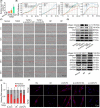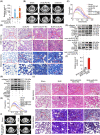circELP2 reverse-splicing biogenesis and function as a pro-fibrogenic factor by targeting mitochondrial quality control pathway
- PMID: 38159063
- PMCID: PMC10844706
- DOI: 10.1111/jcmm.18098
circELP2 reverse-splicing biogenesis and function as a pro-fibrogenic factor by targeting mitochondrial quality control pathway
Abstract
Idiopathic pulmonary fibrosis (IPF) is considered as a chronic, fibrosing interstitial pneumonia with unknown mechanism. The present work aimed to explore the function, biogenesis and regulatory mechanism of circELP2 in pulmonary fibrosis and evaluate the value of blocking circELP2-medicated signal pathway for IPF treatment. The results showed that heterogeneous nuclear ribonucleoprotein L initiated reverse splicing of circELP2 resulting in the increase of circELP2 generation. The biogenetic circELP2 activated the abnormal proliferation and migration of fibroblast and extracellular matrix deposition to promote pulmonary fibrogenesis. Mechanistic studies demonstrated that cytoplasmic circELP2 sponged miR-630 to increase transcriptional co-activators Yes-associated protein 1 (YAP1) and transcriptional co-activator with PDZ-binding motif (TAZ). Then, YAP1/TAZ bound to the promoter regions of their target genes, such as mTOR, Raptor and mLST8, which in turn activated or inhibited the genes expression in mitochondrial quality control pathway. Finally, the overexpressed circELP2 and miR-630 mimic were packaged into adenovirus vector for spraying into the mice lung to evaluate therapeutic effect of blocking circELP2-miR-630-YAP1/TAZ-mitochondrial quality control pathway in vivo. In conclusion, blocking circELP2-medicated pathway can alleviate pulmonary fibrosis, and circELP2 may be a potential target to treat lung fibrosis.
Keywords: YAP1/TAZ; circRNA; miRNA; mitochondrial quality control pathway; pulmonary fibrosis.
© 2023 The Authors. Journal of Cellular and Molecular Medicine published by Foundation for Cellular and Molecular Medicine and John Wiley & Sons Ltd.
Conflict of interest statement
The authors declared no potential conflicts of interest with respect to the research, authorship and/or publication of this article.
Figures







Similar articles
-
YAP1/Twist promotes fibroblast activation and lung fibrosis that conferred by miR-15a loss in IPF.Cell Death Differ. 2019 Sep;26(9):1832-1844. doi: 10.1038/s41418-018-0250-0. Epub 2019 Jan 15. Cell Death Differ. 2019. PMID: 30644438 Free PMC article.
-
hnRNPL-activated circANKRD42 back-splicing and circANKRD42-mediated crosstalk of mechanical stiffness and biochemical signal in lung fibrosis.Mol Ther. 2022 Jun 1;30(6):2370-2387. doi: 10.1016/j.ymthe.2022.01.045. Epub 2022 Mar 10. Mol Ther. 2022. PMID: 35278674 Free PMC article.
-
Mechanosignaling through YAP and TAZ drives fibroblast activation and fibrosis.Am J Physiol Lung Cell Mol Physiol. 2015 Feb 15;308(4):L344-57. doi: 10.1152/ajplung.00300.2014. Epub 2014 Dec 12. Am J Physiol Lung Cell Mol Physiol. 2015. PMID: 25502501 Free PMC article. Clinical Trial.
-
New insights into the Hippo/YAP pathway in idiopathic pulmonary fibrosis.Pharmacol Res. 2021 Jul;169:105635. doi: 10.1016/j.phrs.2021.105635. Epub 2021 Apr 27. Pharmacol Res. 2021. PMID: 33930530 Review.
-
The Hippo Pathway as Drug Targets in Cancer Therapy and Regenerative Medicine.Curr Drug Targets. 2017;18(4):447-454. doi: 10.2174/1389450117666160112115641. Curr Drug Targets. 2017. PMID: 26758663 Review.
Cited by
-
Emerging roles of noncoding RNAs in idiopathic pulmonary fibrosis.Cell Death Discov. 2024 Oct 21;10(1):443. doi: 10.1038/s41420-024-02170-5. Cell Death Discov. 2024. PMID: 39433746 Free PMC article. Review.
-
Biogenesis and Function of circRNAs in Pulmonary Fibrosis.Curr Gene Ther. 2024;24(5):395-409. doi: 10.2174/0115665232284076240207073542. Curr Gene Ther. 2024. PMID: 39005062 Review.
-
Integrative Analysis Reveals STC2 as a Prognostic Biomarker of Laryngeal Squamous Cell Carcinoma.Appl Biochem Biotechnol. 2024 Jul;196(7):3891-3913. doi: 10.1007/s12010-023-04727-z. Epub 2023 Oct 4. Appl Biochem Biotechnol. 2024. PMID: 37792175
-
The role of epigenetics in pulmonary fibrosis: recent advances in mechanistic insights and therapeutic implications.Front Mol Biosci. 2025 Jul 17;12:1647300. doi: 10.3389/fmolb.2025.1647300. eCollection 2025. Front Mol Biosci. 2025. PMID: 40746422 Free PMC article. Review.
-
Network pharmacology and experimental verification to investigate the mechanism of isoliquiritigenin for the treatment of Alzheimer's disease.Sci Rep. 2025 Feb 5;15(1):4379. doi: 10.1038/s41598-025-88542-y. Sci Rep. 2025. PMID: 39910202 Free PMC article.
References
-
- Jia Y, Li X, Nan A, et al. Circular RNA 406961 interacts with ILF2 to regulate PM2.5‐induced inflammatory responses in human bronchial epithelial cells via activation of STAT3/JNK pathways. Environ Int. 2020;141:105755. - PubMed
Publication types
MeSH terms
Substances
Grants and funding
LinkOut - more resources
Full Text Sources
Molecular Biology Databases
Research Materials
Miscellaneous

